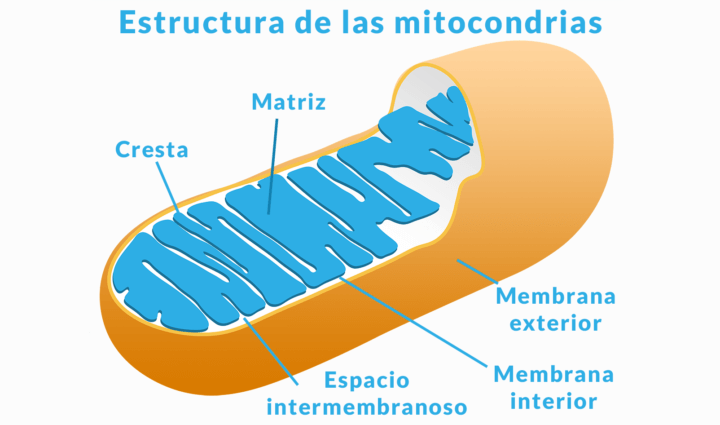Mitochondria are cellular structures in charge of transforming nutrients into compounds that supply cells with the energy necessary for their functioning . These compounds are obtained after synthesizing glucose, amino acids and various fatty acids in the body, converting them into molecules called adenosine triphosphate (ATP).
Due to their importance for the correct cellular functioning, these structures are elementary: their quantity and size can vary according to the type of cell, and they are considered as an energy engine , since they provide the greatest amount of energy necessary and promote cellular respiration. .

Structure of mitochondria
Mitochondria have an oval shape, with a length between 0.5 and 1 micrometer, standing out for its large size over the rest of the organelles.
They are covered by a double membrane, the outer or smooth and the inner, separated from each other by an intermembrane space . The latter retains the protons or energized particles obtained in enzymatic processes.
The outer membrane has protective functions as well as retention of integral porin-type proteins. For its part, the inner membrane contains biological catalysts or enzymes, and is characterized by its folds called mitochondrial ridges .
This last membrane has a liquid matrix with mitochondrial deoxyribonucleic acid (mDNA), which contains genetic information on protein synthesis. In this matrix, the Krebs cycle is carried out, in which energy is generated through the metabolization of nutrients.
For their part, the mitochondrial crests favor the respiration of cells, the transport of proteins and electrons, and the synthesis of ATP.
In relation to their chemical composition, these organelles have lipids, proteins and phospholipids in their structure, which favor the functioning of cells. Likewise, they have deoxyribonucleic acid (DNA), ribonucleic acid (RNA), phosphate and calcium ions (ATP-ADP), mytribosomes, enzymes and other elemental compounds.

Function of the mitochondria
The main function of the mitochondria is the generation of the energy required by the cells , which is synthesized in adenosine triphosphate (ATP). For this reason, it is considered that they are the "combustion engine" of the cell, since they favor the activity of the cells thanks to the processes of aerobic respiration.
Due to their importance, mitochondria have been studied for a long time, reflecting various important functions for the proper functioning of the body, including:
Production of energy for cells
It is considered the most important function of the mitochondria, since it allows the correct cellular function. These organelles take advantage of the oxygen obtained in cellular respiration to generate the energy of organic molecules, releasing and synthesizing ATP.
The cellular respiration process occurs mainly in the mitochondria through the following steps:
- Glucose metabolization or glycolysis: it is carried out mainly in the cytoplasmic matrix of the cell, that is, outside the mitochondria. This process promotes the transformation of glucose to obtain two molecules of pyruvate and ATP, essential for the following steps.
- Transformation or oxidation of pyruvate : in this stage the processed fatty acids enter the mitochondria, binding to a coenzyme A, also called acyl-CoA. These coenzymes are transporter molecules for carnitine, a chemical compound synthesized from the amino acids lysine and myionin, considered essential. Subsequently, the enzymes of the cell matrix transform pyruvate into acetyl-CoA, thanks to oxidative decarboxylation.
- Krebs cycle: also called the tricarboxylic acid cycle (TCA) or the citric acid cycle. During this stage, acetyl-CoA is degraded until obtaining water, carbon dioxide and two molecules: nicotinamide adenine dinucleotide (NADH) and flavin adenine dinucleotide (FADH 2 ).
During this process, the greatest amount of coenzymes necessary for the production of ATP in cellular respiration is obtained. In the Krebs cycle, 24 of the 38 necessary adenosine triphosphates are synthesized in the mitochondrial matrix of eukaryotic cells; in the case of prokaryotic cells this stage develops in the cytoplasm. - Oxidative phosphorylation or synthesis of adenosine triphosphate: in this step the molecules of NADH and FADH 2 , which have electrons, are synthesized into ATP by the reaction of proteins in the inner membrane of the mitochondria. In this stage the molecules transfer their electrons to oxygen, generating the respiratory chain or transport chain to synthesize ATP and obtain energy.
Thermogenesis or temperature regulator
Mitochondria, thanks to the transformation of molecules through their catabolic activity, have the ability to generate heat . In the same way, they allow to regulate the temperature in warm-blooded living beings .
Apoptosis or cell cycle control
Mitochondria have the ability to program the death of cells in a controlled manner. This function allows you to intervene in their growth, development and replacement. Apoptosis should not be related to necrosis, which is the uncontrolled death process of cells.
Storage of calcium ions (Ca 2+ )
Mitochondria intervene in the biochemical processes of cells, storing and managing calcium ions. These ions promote bone health, the reaction of neurotransmitters in neurons, and the contraction of muscles .
Protein synthesis and self-replication, the main function of mitochondria
Mitochondria have the ability to synthesize proteins, transforming the information from their characteristic DNA to other RNA molecules , without the intervention of other cellular organelles such as ribosomes.
Intervention and regulation of sex hormones
Mitochondria are involved in the process of producing sex hormones such as testosterone and estrogen. Thanks to their ability to self-replicate by possessing their own DNA, they can transcribe the genetic information of these hormones during cell division.
conclusion
Mitochondria are organelles or elemental structures in eukaryotic cells (characterized by having a well-defined nucleus and multiple chromosomes) of living beings. Its main function is the transformation of proteins into useful energy for cells , synthesizing chemical molecules called adenosine trisphophate (ATP).
Similarly, due to their catabolic capacity and because they have their own DNA, they have the ability to regulate body temperature and intervene in important processes within the body such as protein synthesis , calcium storage and cell regeneration, being considered the elemental motor of cells.
References
- Friedman, J. and Nunnari, J. (2014). Mitochondrial form and function. Nature . doi: 10.1038 / nature12985
- Goodenough, U. and Heitman, J. (2014). Origins of Eukaryotic Sexual Reproduction. Cold Spring Harbor Laboratory Press . doi: 10.1101 / cshperspect.a016154
- Microsoft Encarta. (2009). Mitochondria. For Microsoft Corporation. [Revised February 2020].
- Vidyasagar, A. 2015. What Are Mitochondria? For Live Science. [Revised February 2020].